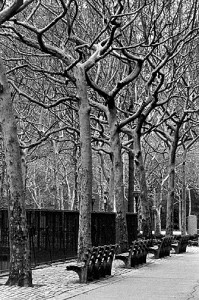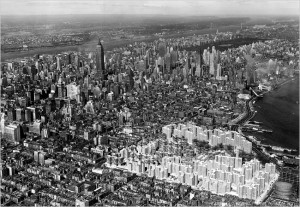A Slice of Life …
The Lower East Side of Manhattan
Stuyvesant Town and Peter Cooper Village Are Highlighted
The following video is a segment of a PBS broadcast about Robert Moses and the post-war re-building of New York City. Mid-way, it features the development in which I grew up, Stuyvesant Town and how it replaced hundreds of tenement buildings and displaced thousands of people.
It is interesting to note that the original purpose of the building of Stuyvesant Town was to provide affordable housing to the World War II veterans and their families. At this time the management has changed hands several times, there are issues with bankruptcy, rents are enormous and have out-priced the average middle-class renter. To fill apartments, the management put in temporary pressure walls and bills them as having more bedrooms. As a result, the development no longer appears to cater to the family model, but rather acts as an extension of New York University housing. When there is a transient population there is not the same investment in the environs. The young population living away from home, several to an apartment, paying thousands of dollars, is often disrespectful, noisy, dirty.
Despite all the “improvements” in landscaping and amenities, I’ll take my memories of spare and sterile and “keep off the grass.”
The discussion is raised in the video that in razing the old houses, communities and connections were lost. Then the question: is the new always better than the old?
Everything is relative.
With all the newness and improvements that have since been made to Stuyvesant Town history has repeated itself.
[According to a news item on rents in New York City, this evening, the average rent is $3,000.]



Certainly the good old days are relative. There are plenty of things some would like to go back to but also just as many things we would not like to return to. Most likely for those living at the time, they were a step up from the previous generation, and so on. Only now we find ourselves living an unsustainable lifestyle of consumption. How many more generations will be able to use good old days in the same way that we have , and not in the way in which they really do in almost every way wish it was 50 years earlier. One good sign, the younger generation does not value car ownership nearly as high as previous generations, they are purposely living in the city, with less. I think the idea that less is more is on the rise.
Thanks very much, I enjoyed your comment.
Here’s an interesting article for you.
http://www.nytimes.com/2013/07/23/nyregion/mta-ponders-transit-for-a-new-generation.html
I loved your article and short movie about Robert Moses. Being a former resident of Stuyvesant Town, I loved that you showed a movie of the destruction of the old buildings for the “new”.
Perhaps in this version of the story of Moses, it is he who forged the golden calf of urban renewal while the promise of better days to come , descending from the mountain top, was shattered by his wrecking balls. A vibrant community cannot be built from new concrete and glass as much as it must be woven together through individual lives criss-crossing each other each and every day.
Thanks for the insightful comment; well-done.
It seems we live on a change continuum: new takes over old and becomes the new norm. The new norm becomes the new good old days. Who is to say that the kids who lived in the tenements that preceded Stuyvesant Town were disadvantaged? their “good old days” may have meant playing stick ball in the street and living in dark railroad flat style apartments with toilets in the hall, but that’s how things were, what everyone had and what they knew to be “life.”
Then comes Stuyvesant Town and there is no more playing in the street or running through open fire hydrants. We were in a “safe” haven compared to OUR predecessors and we had bathrooms in our apartments and elevators.
The new normal includes rents that are $3-5+ thousand a MONTH, ultra landscaping, concierge service, a gym, skating rink in a playground and a gazillion NYU kids living off their parents, sharing apartments, making a racket at all hours puking on the lawns after nights of binge drinking, outdoor sexual activity in the dark against buildings, semi-nude sun-bathing on lawns we were never allowed to step on. There are still elderly original tenants who I am sure can’t believe what they see and hear.
It seems as though the human condition is always the same. We make our memories from the theater of interactions and relationships we establish and the streets and buildings become the backdrop of the set.
I guess “all the world is a stage.”